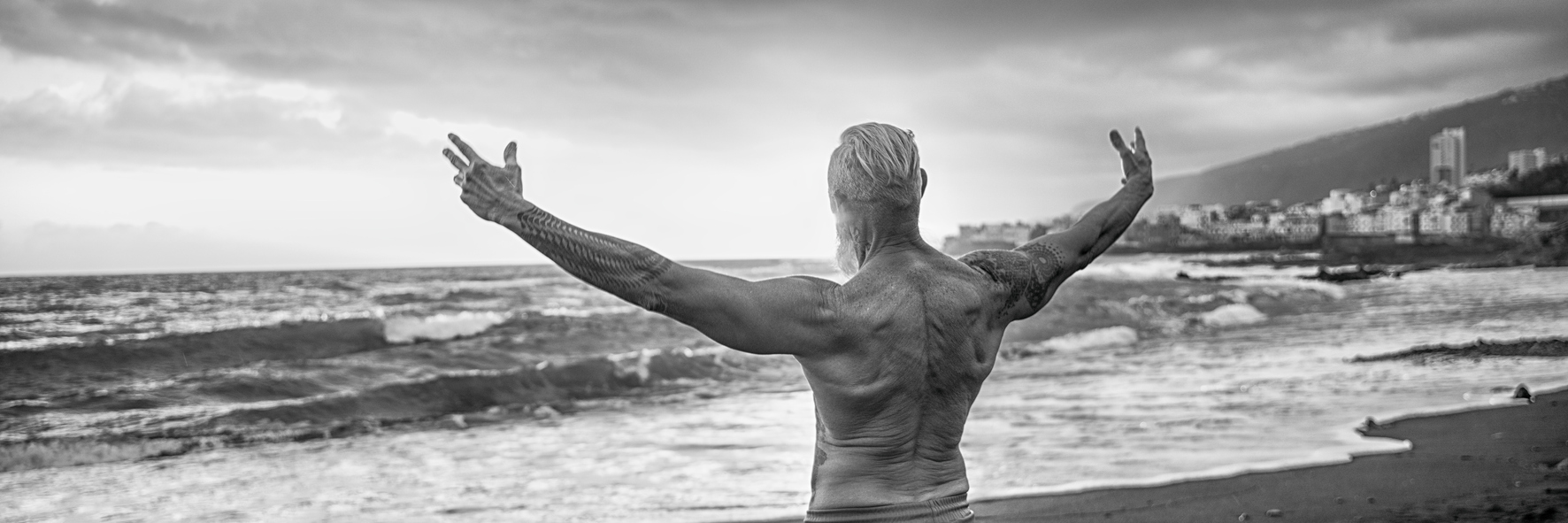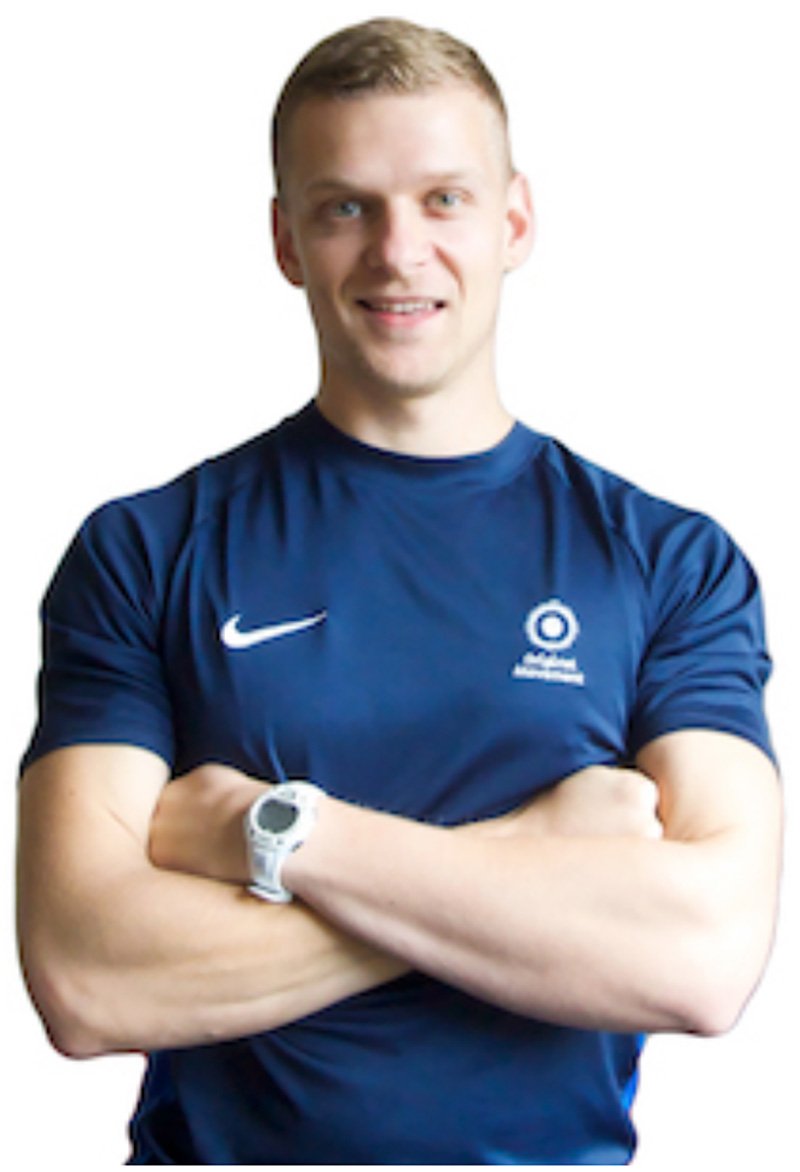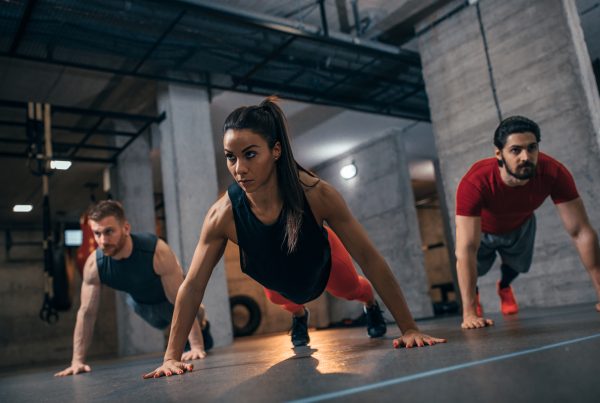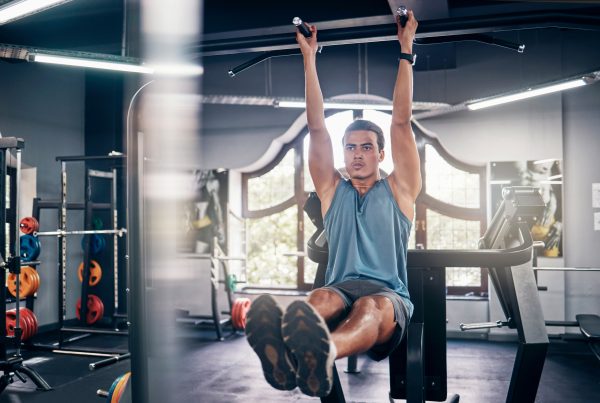Stephen Tongue takes you through training the back muscles using a variety of different equipment, from no kit at all to kit you can take with you wherever you are.
A strong back always looks so impressive and desirable and can help us with good posture, performance-based lifting tasks and a strong healthy core that helps protect us from injury. Back training often gets neglected, partly because those muscles aren’t staring back at us in the mirror and partly because, if you don’t have access to specialist equipment such as resistance machines or weighted cables, they are not an easy muscle group to train. Whether you’re a mobile PT, train in your own home gym or just like to train in the open air/green spaces, what are your options for training your back without access to a shipping container full of barbells, dumbbells and weight machines? In this article, we explore options for training back muscles with a variety of different equipment levels, from no kit at all to smart-choice kit that is mobile enough to train wherever you want to.
The key issue with back training outside of the gym is the forces that the back muscles can create; we can lift so much weight with our back muscles that it just wouldn’t be practical to carry it all into the park for a sesh. We can pull much more weight than we can push because we have some seriously large and powerful muscles in our backs. The latissimus dorsi or ‘lats’ are the large muscles which help to give us that ‘V’ shaped torso and, when trained, are capable of lifting well over our bodyweight. Lats are particularly active when pulling downwards on a resistance from above. The trapezius is the large kite-shaped muscle that sits in the centre of our back and works hardest when pulling in towards your torso from a variety of angles, another super-strong muscle group. To train such muscles without stacks of weights, we need to get a little creative but it is still possible to build strength without the barbells.
Zero fitness equipment
Perhaps you’re on a business trip/holiday or maybe you want to get in shape but just haven’t invested in any equipment yet? That’s not an excuse not to work out – there are plenty of bodyweight exercises you can do and, with a few household items, you can still train your back as well as all your other muscle groups. Here are some simple ideas for back training with zero equipment.
Bath towel
An easy find in any home or hotel room, a bath towel is strong and easy to grip, not to mention the convenience of mopping the sweat from your brow. To give the towel extra strength and reduce risk of it tearing, twist the towel to give it more strength.
Isometric deadlift
Target muscles: Trapezius, erector spinae, glutes, hamstrings
Standing on the towel and gripping each end towards the corners at below knee height puts you in a position where you can apply high force with an isometric deadlift. Perform six to 12 reps, pulling hard on the towel for five to 10 seconds at a time. Be sure to keep a long straight spine, bent knees and flat feet. This is simple but can be really hard work – try to pull with 70-80% effort rather than going all out and doing yourself a mischief by maxing out on every rep. If you begin to feel lightheaded, be sure to stop and recover before reducing the effort level. This exercise creates lots of whole-body tension and fires up the whole posterior chain.
Prone towel pull
Target muscles: Trapezius, erector spinae, latissimus dorsi
Lying on your front, grip the towel just slightly wider than shoulder width. Pull your hands apart while gripping the towel to create maximum tension – imagine you’re trying to tear it in two. Lifting your chest up from the ground along with your feet, pull the towel down behind the head until it’s above the scapula, just as you would on a lat pulldown machine. Slowly return to the start position while keeping the ‘tearing tension’ on the towel at all times. This exercise is great for getting tension on the lats, traps and rhomboids, which are not easy to tap into without equipment. As this is a low-load exercise, perform 10-20 reps for two or three sets.
Bed sheet
A bed sheet is another item you can easily put your hands on in a home or hotel room. Fold it into a triangle and, taking the ends furthest apart, twist it as with the towel to give it extra strength. Bed sheets rip more easily than towels, so it’s important that you bind it tightly. Next up, a large roll of tape is required (such as gaffer tape); this acts as an anchor point. Feed the sheet through the tape and place over a heavy, sturdy door. Note that, when placing the anchor, you should ensure you place it closer to the stronger, hinge side of the door and that you’re pulling the door closed. Ideally, lock the door or place a ‘do not open’ sign on the other side. Don’t have tape? You can tie a few large knots in the sheet to act as an anchor but be aware that the knot can get smaller or come undone when weighted, so it must be frequently checked during use.
Bed sheet row
Target muscles: Trapezius, biceps
Take on offset stance to reduce risk of slipping; the closer you move the front foot to the base of the door, the harder the exercise will be. Keep alignment of your body in an upright and stiff plank posture. Pull your elbows back behind your ribs and squeeze your shoulder blades together. Slowly return and repeat. This is a medium-load exercise, so perform 10-20 reps for two or three sets.
Bed sheet fly
Target muscles: Trapezius, deltoids
Use the same set-up as for the bed sheet row, except this time start with wide arms in a ’T’ position. Keeping long arms, lower your body backwards with control and, without being tempted to bend your arms, pull back up to the ’T’. This is a medium-load exercise, so perform 10-20 reps for two or three sets.
Low cost, lightweight and mobile kit
If you only have a small budget but need a workable solution, I have you covered. Strength bands are great for this, as they come in a variety of strength grades and can withstand a lot of force. My strength bands of choice are TRX Bandits as they come with their very own innovative and comfortable handles for a great grip on the band.
Strength band without an anchor
If you’re just in an open space such as a large room or a field with nothing sturdy enough to anchor onto, then these exercises are for you.
Strength band deadlift
Target muscles: Trapezius, erector spinae, glutes, hamstrings
Slip your handles onto a medium to strong strength band or grip either end of the loop and half twist one side to make an ‘X’ shape in the band. Lower the X onto the ground and stand your feet either side of it. The purpose of the X is to create more tension and to reduce the chances of the band slipping from underneath your feet. Adopt a low deadlift position with low hips, high chest and a flat back. Pull through on the band and extend up to a tall position before a return and repeat.
Strength band bent over row
Target muscles: Trapezius, erector spinae, biceps
Set up the band with the X position as for the deadlift and this time place one foot directly on the centre of the X. The other foot takes a long step back. Keeping your weight on your front foot, extend your spine into a good neutral posture and perform a narrow row on the band, trying to isolate movement to the shoulders and elbows. Repeat even reps on both legs.
Strength band with anchor point
If you have a sturdy anchor point which can take your weight, such as a substantial tree or fence post, then you can take advantage of a greater number of options. A strong narrow anchor such as a signpost or goalpost means you can just loop the band around and take an easy set-up for a high, low or mid anchor point. Broader anchors such as large trees will require an extender strap or climbing sling, which can be wrapped around the anchor and then linked using a carabiner. Again, the height of this is easily changeable for a high, mid and low anchor point.
Strength band squatted row
Target muscles: Trapezius, biceps, quads
Once the band is anchored, walk backwards to a point of tension, drop into a low squat and, maintaining your balance, perform a unilateral or isolateral narrow row.
Strength band face pull
Target muscles: Trapezius, biceps
Take an anchored band and walk back into tension. Adopt an offset position with the feet, stand tall and perform a wide-arm unilateral row at shoulder height.
Strength band lat pulldown
Target muscles: Lats, biceps
This requires a high anchor point – head height or just above. Take both ends of the band lower onto one knee and draw the handles downward and into the ribs, being sure to keep a tall, positive posture.
Heavy duty, professional and mobile kit
If you are working professionally with clients, then you should invest in professional equipment and get yourself trained up on how to use it most effectively and efficiently. Both of these pieces of kit, if well looked after, are one-off lifetime purchases and will pay for themselves over and over again.
Kettlebells
Kettlebells are super-sturdy, robust pieces of kit. Of course, if you go for a very heavy kettlebells, you will not be able to carry them very far. Some more specialist kettlebells offer more mobility, such as adjustable-weight kettlebells that use lead shot to adapt the weight or water-filled kettlebells, which can be emptied and refilled as desired but may be less robust.
Suitcase deadlift
Target muscles: Trapezius, erector spinae, glutes, hamstrings, obliques
Placing the kettlebell to the outside of the foot, adopt a low deadlift position, grip up and deadlift to a tall posture. Visualise lifting two kettlebells symmetrically to help cue a balanced lift. The challenge here is to make the lift look symmetrical, meaning that the opposite-side core musculature is working hard to stabilise the trunk in lateral flexion. Repeat both sides evenly.
Renegade row
Target muscles: Trapezius, biceps, abs
In a press-up position with the kettlebell placed between your hands, stay stable and row with alternate arms, doing your best to return the bell centrally each time and maintaining a positive plank position.
Swing
Target muscles: Erector spinae, glutes, hamstrings
This is the classic kettlebell lift. For a hinge-style lift, deadlift the kettlebell, thrust it off the hips to gather momentum and swing under the hips before driving forwards again with a powerful, well-timed hip thrust. Keep just a slight bend in the knees, a long straight back and try to isolate the movement to the hips.
Good morning
Target muscles: Erector spinae, glutes, hamstrings
Another hinge-style exercise. Invert the kettlebell and wrap your hands around the bell itself. With feet hip-distance apart, hinge at the hip and keep a long, flat spine. Fold until you feel tension on the hamstrings and return. Don’t allow the load to pull your spine into flexion.
Suspension trainer
My suspension trainer is my ultimate fitness travel companion. It’s lightweight and has its own packable bag, meaning you can take it with you to the beach, on runs or just for use in hotels with the additional door anchor, which is included. For efficient use, try to set up the straps so that when they are fully lengthened they hang approximately three to six inches from the ground. Suspension trainers have a large exercise library to boot but here are a few effective back exercises to get you started. Note that, with all of the below exercises, the closer your feet are planted in relation to the anchor point, the harder the exercise becomes. Always start with an easier position to find good form and then progress your feet further forwards until you feel challenged.
Suspension trainer power pull
Target muscles: Trapezius, biceps, obliques
Set the straps to mid length and, facing the anchor point, grip one handle, pulling it tight into the shoulder to create tension on the strap. The free arm lengthens up along the strap until your body twists. Lengthen backwards and downwards through the arms until you are at full wingspan. To return, pull hard on the handle and reach your free arm back up along the strap until you return to the start position.
Suspension trainer low row
Target muscles: Trapezius, biceps
Set the straps to a fully shortened position and start facing the anchor point with hands on both handles and symmetrical feet. Start with arms bent fully and elbows tucked in before lowering your body down with your arms to full extension; pull yourself back up and repeat. Note that your body should remain rigid and straight in good posture while your arms perform the movement.
Suspension trainer overhead back extension
Target muscles: Erector spinae, glutes, hamstrings
Straps are mid length and the starting position is facing the anchor point, with feet spread wider than the hips and arms spread wide above the head. Lower back your hips while maintaining a straight spine and gripping the floor with your heels. Keeping the arms and legs long, drive the hips back through to the start position.
Suspension trainer IYT fly
Target muscles: Erector spinae, deltoids
Straps are mid length and the starting position is facing the anchor point with feet spread hip-distance apart yet slightly offset. Hands are held up at full arm’s length above the head and straps are under tension. Lower your arms to shoulder height, keeping your body in an upright plank and maintaining the body position and long arms; pull the handles back up above your head to the start position. Repeat this with wider hands above shoulder height for the Y fly and arms level at shoulder height for the T fly.
Summary
With a little imagination and investment, your options for back exercises can increase. Always plan ahead and put safety first, doing necessary risk assessments, testing equipment and seeking certified training where necessary. Plan ahead for logistically moving equipment safely and test anchor points rigorously. Focus on form first before undertaking progressions and try to work a variety of exercises and lines of pull to work out all of the key muscles across the back. Get back to it.








